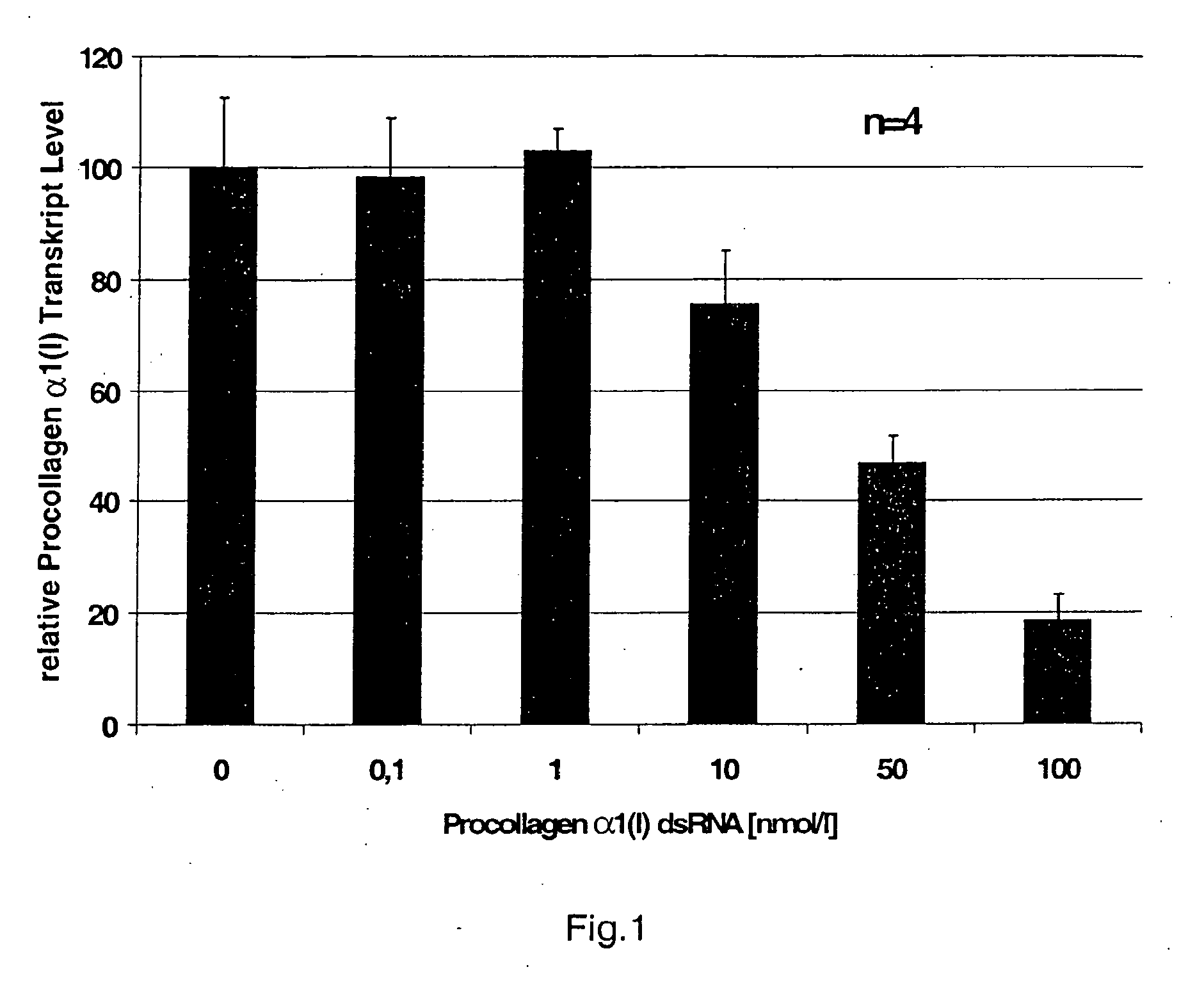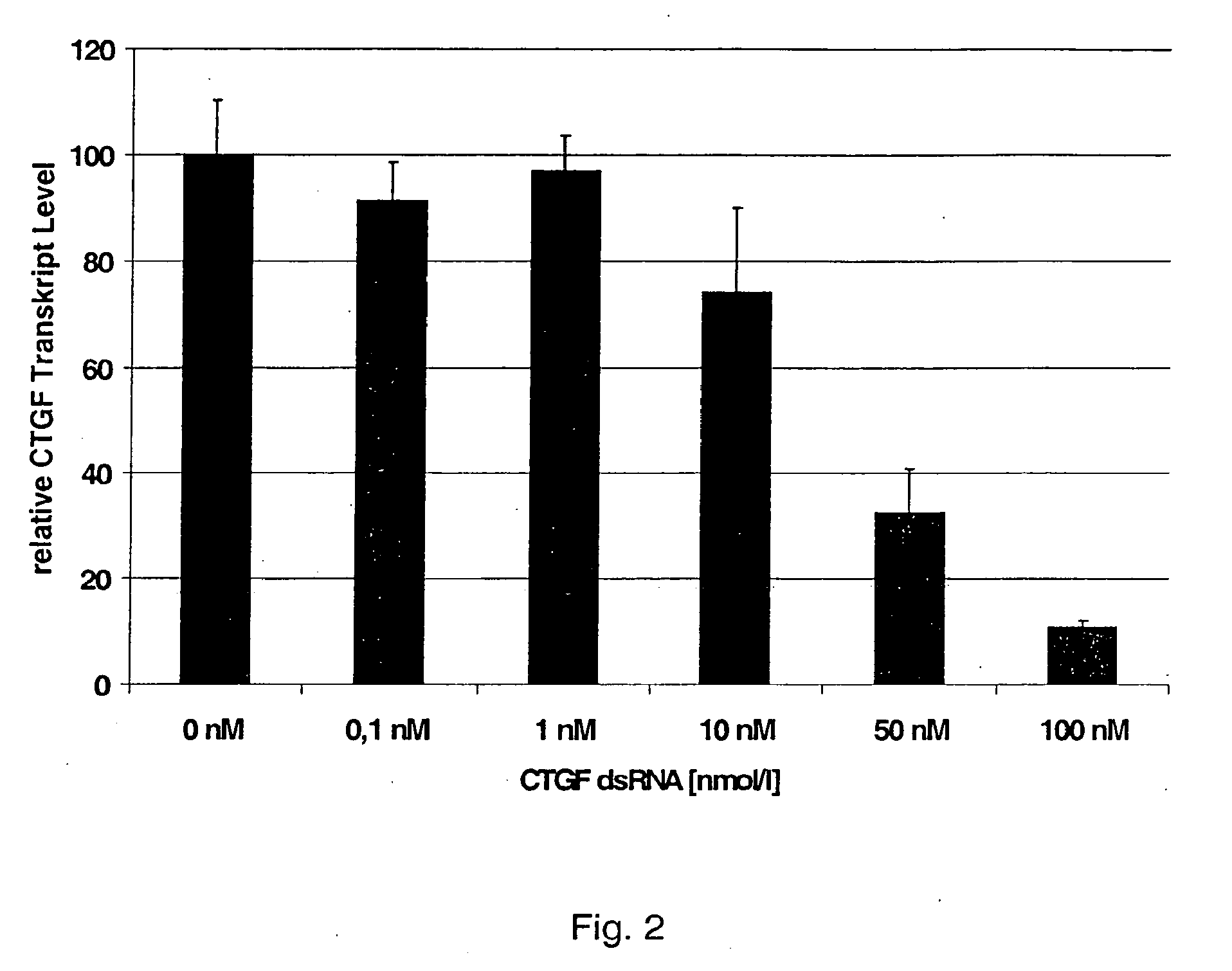[0008] Experiments to treat fibrotic disease by means of
antisense oligonucleotides have made it appear that there is little prospect for a molecular biological approach. Surprisingly, however, it has been shown that it is possible to effectively inhibit new formation of
connective tissue and ECM, respectively, by means of double-stranded ribonucleic acid. The genes involved in the formation of
extracellular matrix are, in terms of the invention, also genes that lead to the formation of factors that cause cells to produce extracellular matrix, or to transform into cells that produce extracellular matrix. Such factors include
platelet-derived
growth factor (PDGF);
transforming growth factor-β (TGF-β), especially TGF-β1, TGF-β2, or TGF-β3;
connective tissue growth factor (
CTGF); or oncostatin-M. These factors can, for example, initiate and sustain
transdifferentiation of hepatic star cells and portal fibroblasts into a
phenotype that is similar to myofibroblasts. In contrast to the original cells, this
phenotype exhibits an increased
proliferation rate and matrix synthesis, often at the same time as reduced breakdown of extracellular matrix (fibrolysis) by matrix-degrading
proteases. Liver cells other than hepatic star cells or portal fibroblasts can produce these factors.
[0014] It has been shown to be particularly advantageous when at least one end of the dsRNA exhibits a single-stranded overhang consisting of 1 to 4, in particular of 2 or 3, nucleotides. In comparison to dsRNA without single-stranded overhangs at least one end, such dsRNA demonstrates superior effectiveness in inhibiting expression of the
gene. Here, one end is a dsRNA region in which a 5′- and a 3′-strand-end is present. DsRNA consisting only of the strand S1 accordingly exhibits a loop structure and only one end. DsRNA consisting of the strand S1 and a strand S2 exhibits two ends. Here, one end is formed in each case by a strand end on the strand S1 and one on the strand S2.
[0015] The single-stranded overhang is preferably located at the 3′-end of the strand S1. This location of the single-stranded overhang leads to a further increase in the efficiency of the medicament. In one example, the dsRNA exhibits a single-stranded overhang at only one end, in particular, at the end located at the 3′-end of the strand S1. In dsRNA that exhibits two ends, the other end is blunt, i.e., without overhangs. To enhance the interference action of dsRNA, it has, surprisingly been shown that it is sufficient for dsRNA to have an overhang at one end, without decreasing stability to such an extent as occurs with two overhangs. A dsRNA having only one overhang has proven to be stable enough and particularly effective in a variety of
cell culture media, as well as in blood, serum and cells. Inhibition of expression is particularly effective when the overhang is located at the 3′-end of the strand S1.
[0016] In addition to the strand S1, the dsRNA preferably exhibits a strand S2, i.e., it is made up of two separate single strands. The medicament is particularly effective when the strand S1 (antisense strand) is 23 nucleotides long, the strand S2 is 21 nucleotides long, and the 3′-end of the strand S1 exhibits a single-stranded overhang consisting of two nucleotides. The dsRNA end that is located at the 5′-end of the strand S1 is blunt. The strand S1 can be complementary to the primary or processed
RNA transcript of the
gene. Preferably, the dsRNA consists of the strand S2, having Sequence No. 3 and the strand S1, having Sequence No. 4, or of the strand S2, having Sequence No. 5, and the strand S1, having Sequence No. 6, in accordance with the attached sequence listing. Such dsRNA is particularly effective in inhibiting the expression of the gene that codes for Type α1(I) procollagen or
CTGF and that is involved in the formation of extracellular matrix.
[0017] The medicament may exhibit a preparation suitable for
inhalation, oral
ingestion, infusion or injection, in particular for intravenous or intraperitoneal infusion or injection, or for infusion or injection directly into a tissue affected by the fibrotic disease. A preparation suitable for
inhalation, infusion, or injection can most simply consist, in particular exclusively, of the dsRNA and a physiologically tolerated
solvent, preferably a
physiological saline solution or a physiologically tolerated buffer, in particular a
phosphate buffered
saline solution. Surprisingly, it has been shown that dsRNA that has simply been dissolved and administered in such a buffer or
solvent is taken up by the cells that express the gene. Expression of the gene, and therefore also the disease, are inhibited without the dsRNA having had to be packaged in a special vehicle. The dsRNA can be present in the medicament in a solution, in particular a physiologically tolerated buffer or a
physiological saline solution, surrounded by a micellar structure, preferably a
liposome, a
capsid, a capsoid, or polymeric nano- or microcapsule, or bound to a polymeric nano- or microcapsule. The physiologically tolerated buffer can be a
phosphate-buffered
saline solution. A micellar structure, a
capsid, capsoid, or polymeric nano- or microcapsule can facilitate uptake of dsRNA in cells that express the gene. The polymeric nano- or microcapsule consists of at least one biologically degradable
polymer such as polybutylcyanoacrylate. The polymeric nano- or microcapsule can transport and release in the body dsRNA that is contained in or bound to it.
 Login to View More
Login to View More 


